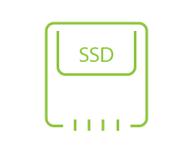The world of digital technology has never looked so bright and interesting. With the continuous developments in artificial intelligence, robotics, virtual reality, Internet-of-things (IoT), machine learning, computer algorithms, smart devices, and automation, the world that we live in over the next 5, 10 and 20 years will be far different than the one we are living in today.
This new and exciting digital world will be driven largely by the management, utilization, and storage of Big Data. Led by cloud computing, advance network equipment will manage Big Data for storage, machine-to-machine business analytics, and even machine learning (making the data that much more powerful).
It is no surprise that data center storage is expected to grow nearly 400% by 2020 and that cloud computing will account for nearly 90% of all data center storage capacity by 2020.
With the anticipated exponential growth in storage and utilization of digital data within the data center, one might ask the question what new network advancements will enable the future management of Big Data.
This will be driven mostly by the following four key technologies: Hyper Converged Infrastructure, Flash Array Storage, Software-Define-Storage, and Cloud Storage.
Hyper Converged Infrastructure

Hyper Converged Infrastructure will combine compute power with storage, networking and virtualization technology – shrinking everything down to a small footprint reduces power consumption and costs.
With the combination of compute and storage, we will see more movement to Ethernet protocol from Fiber Channel as well as an increase in network cabling bandwidth requirements.
Solid State Drives (SSD)
With advancements in Solid State Drives (SSD) and lower price points, flash array storage will someday be the ubiquitous storage technology in data centers.
All flash array storage will have the positive results of less power and cooling requirements as well as increasing the efficiency and density within a data center.
As more storage capacity will be able to fit into a smaller footprint, the network cabling bandwidth requirements will only increase.
At the moment, data transfer rates of 10 Gb/s are becoming the norm. In the future, these data rates will increase to 40G, 100G and beyond.

Software-Defined Storage (SDS)
Software-Defined Storage (SDS) will provide an intelligent software-based control layer on top of the network infrastructure. It will provide orchestration tools to enable you to manage storage resources more efficiently.
SDS also makes data centers more flexible in terms of scalability for increased capacity and performance by allowing users to repurpose and consolidate existing server and storage hardware from any supplier while enabling interoperability with newer, purpose-built hardware stacks.
This added degree of storage scalability requires that your network cabling infrastructure be agile as well as have excess bandwidth capacity.

Hyperscale Cloud Storage
Hyperscale Cloud Storage will provide the scale & bandwidth elasticity to really empower machine learning and artificial intelligence as well as handle all the Big Data from the proliferation of IoT devices.
For example, data set from training driverless cars can be over 100 terabytes per day, which really creates challenges for high speed data movement and management.
As these data requirements only increase over time, the public will be looking to hyperscale cloud providers to provide the storage and computing power to enable machine learning and manage IoT Big Data.
With massive storage capacity requirements, hyperscale Cloud providers will have to deploy very high end network cabling infrastructure products to ensure they have the bandwidth and scalability to manage, utilize, and learn from Big Data.

With the key technology storage drivers above, one can see a common theme. Bandwidth requirements will only go up. The need for scalable and agile network cabling infrastructure will be a must.
As hyperscale cloud providers play a bigger role in the future with the storage and utilization of Big Data and as they begin to integrate the technologies of hyper converged infrastructure, flash array drive and SDS together, the network cabling infrastructure to enable these new technologies will migrate more towards single mode fibre optics and Active Optic Cables (AOCs).
Hyperscale cloud providers will utilize the technology of parallel optics, wave division multiplexing, and data modulation in single mode fibre optics and high end AOCs (QSFP-DD & OSFP) to achieve data rates of 400G and beyond.
The single mode fibre will be used for managing storage data across the entire white space of a hyperscale cloud data center and the AOCs will be used more for short point-to-point network runs between storage and computing equipment.
With machine learning, artificial intelligence and IoT, the future of data storage and utilization is almost boundless. For the hyperscale cloud providers, high speed single mode fibre and AOCs will be the network highway to enable the digital storage revolution of the future.



